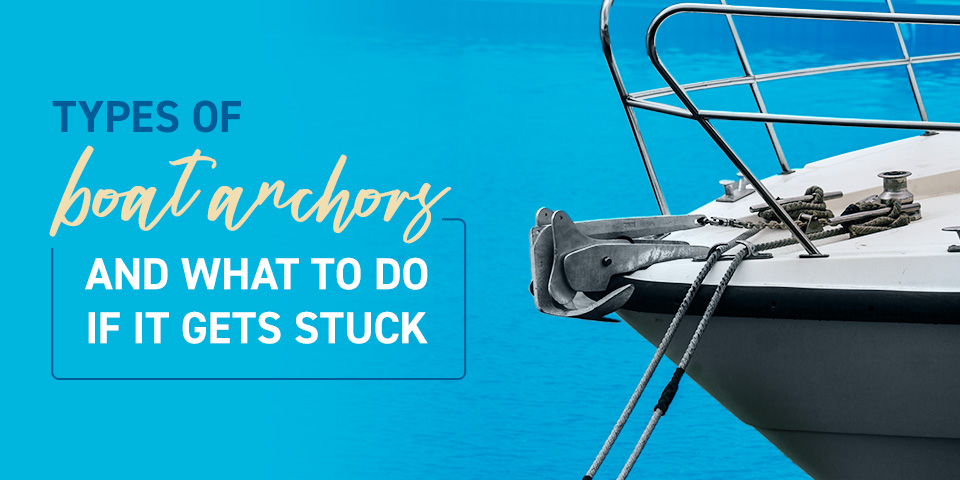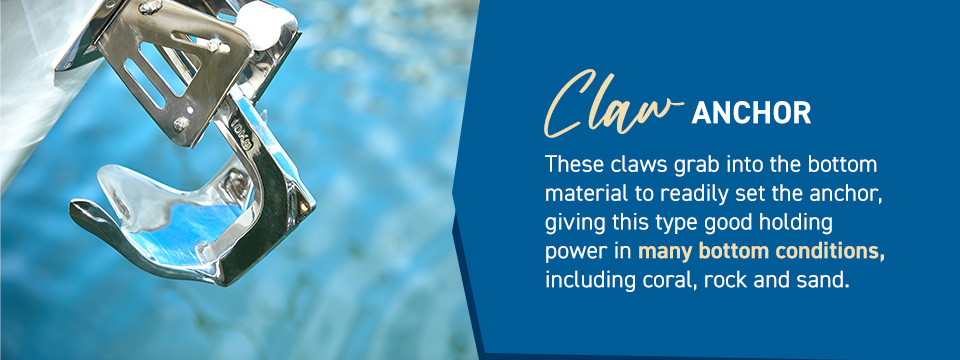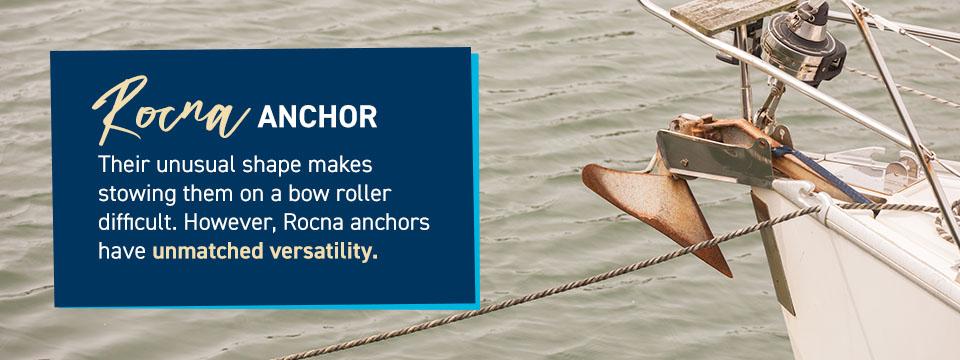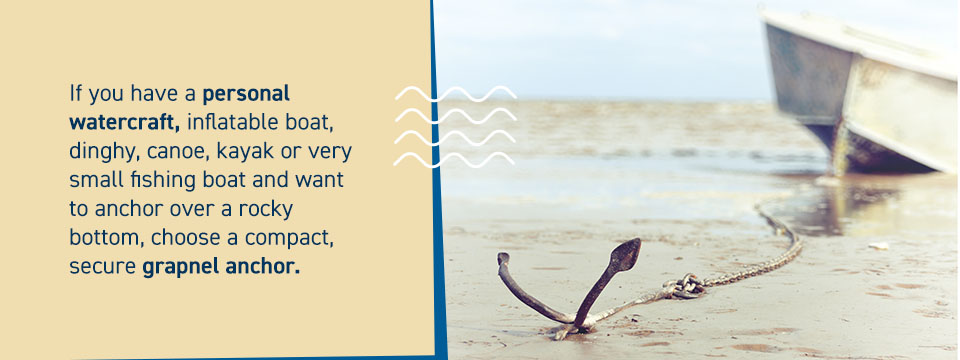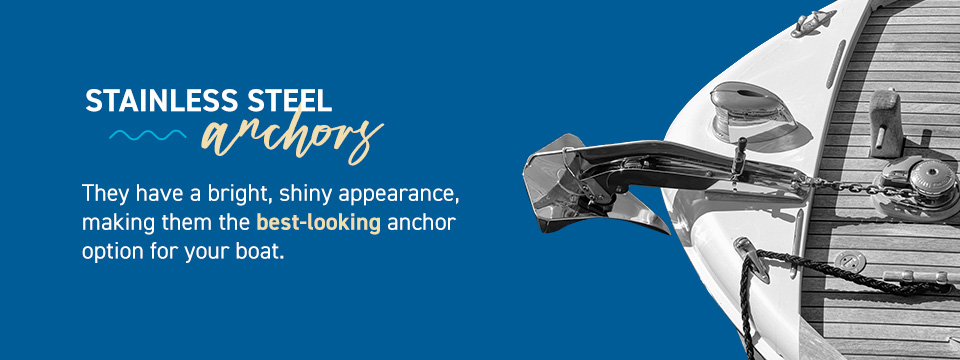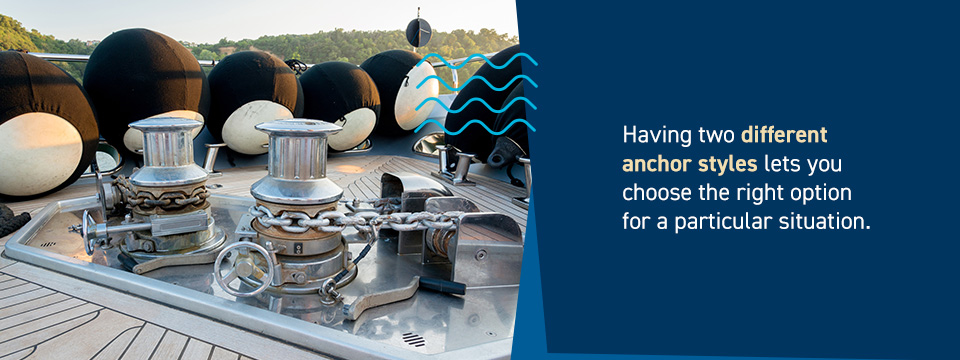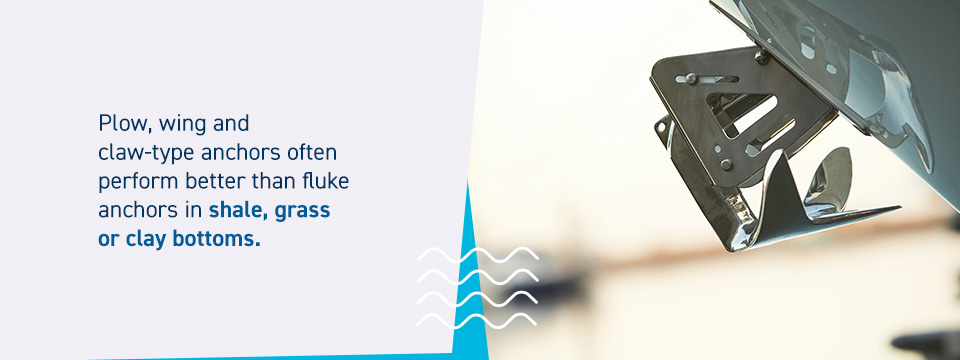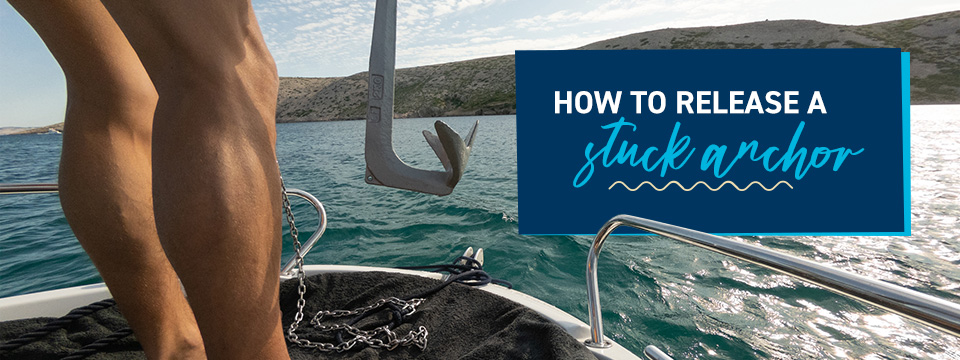Filters
Types of Boat Anchors and What to Do If It Gets Stuck
Boats have several types of anchor options available. This range of options addresses the specific concerns presented by various bottom materials, boat sizes, weather conditions and holding power. The best choice for you relies on how these factors impact your boat. Understanding the variety of boat anchors available and how each distinguishes itself is the first step in selecting the right option to provide your boat with a secure hold.
Types of Boat Anchors
With multiple varieties of boat anchors, choosing the right one for your needs may seem daunting. However, you don’t have to choose one. You should have at least two different styles to meet various bottom or weather conditions. These two anchor types that you keep aboard should also provide the secure hold you need to keep your boat’s weight from drifting. Each anchor shape has advantages and disadvantages that make it best suited for specific situations. Compare the following anchor types to find the right one for your boat.
Claw Anchor
Claw anchors originated with the Bruce Anchor Company, so you may see these referred to by their brand name as Bruce anchors instead of claw types. Other companies manufacture claw anchors with similar design and performance to the original versions from Bruce.
The shape of a claw anchor features three claws on the bottom. These claws grab into the bottom material to readily set the anchor, giving this type good holding power in many bottom conditions, including coral, rock and sand.
Their versatility makes claw anchors one of the most popular options for recreational boaters. However, these anchors are not perfect for all uses.
Claw anchors do not hold well in hard bottom materials, such as clay, shale and grass. Compared to wing-type and other anchor styles, the holding power per pound is less. If you had used a wing-type anchor before, you would need a larger size claw anchor if you switch. The awkward, single-piece shape of the claw anchor also makes storage difficult.
A claw anchor works well enough for the majority of people who take short trips on their boats and need temporary anchorage for a few hours. However, if you travel in areas with grassy or hard bottom conditions, you should look for another option.
Plow Anchor
Among plow anchor types, you may hear the brand names referring to the anchors. Some people refer to plow-type anchors by the brand CQR, though other companies make this anchor style. CQR is an older type of plow anchor with a hinge that allows the head to pivot. Delta is often used interchangeably with wing anchor, another type of plow anchor that comes in one piece.
When lowered, one of the plow sides digs into the bottom for a firm hold in many materials, except soft sand and rocks. If the current or wind shifts, the anchor lifts from the bottom and repositions itself easily without letting the boat drift. The secure hold of plow-style anchors makes them a highly popular option for boaters today, with wing-type anchors surpassing hinged models. Additionally, these anchors have the superior holding power to claw anchors on a weight-to-hold ratio.
Wing-type plow anchors store easily on the bow roller. Hinged models are large and more difficult to stow due to the movement of the hinged plow. The improved holding power of both forms of plow-type anchors often makes up for their larger sizes compared to other anchors.
Rocna Anchor
The Rocna anchor is a multipurpose anchor that sets well and holds firmly in all types of bottom conditions. It can secure large and small boats.
Sometimes referred to as a scoop or spade anchor, the Rocna anchor has an innovative roll bar. This bar turns the anchor into the ideal position for setting. The fluke has a concave design to dig into the ground and secure the anchor. Setting skids on the anchor maintains the anchor’s position once set, providing high holding power for a variety of boats over different bottom conditions.
Rocna anchors have a few downsides. Most notably, these newest anchors are very expensive compared to other models. Their unusual shape also makes stowing them on a bow roller difficult. However, Rocna anchors have unmatched versatility.
Fluke Anchor
A fluke anchor is a lightweight option that excels in mud or sand. Despite its light weight, the fluke holds well in sandy or muddy bottoms, giving it a high capacity for holding compared to its weight.
The anchor design includes two flukes on the sides of the piece that dig into mud or hard sand. This style works well as the primary anchor for a small boat or secondary anchor for other types of boats. With its low weight, this anchor stores easily on bow rollers.
Other names for fluke-type anchors include the brands Danforth and Fortress or the generic term lightweight. You may see these names instead of the term fluke when searching for this type of anchor.
With their light weight and secure hold in mud and sand, fluke-type anchors do have some drawbacks. First, they do not securely hold in rocky, grassy or other hard bottom conditions. Secondly, they are best suited for smaller boats. Larger boats may use these as secondary anchors.
Grapnel Anchor
The grapnel anchor best suits the smallest watercraft, such as kayaks and canoes or small fishing boats. Avoid using it with larger boats since this type of anchor does not have very strong holding power.
Four tines fold out from the anchor to grab onto rocks or other objects on the bottom. This is a rare anchor type that works well for rocky bottoms because it needs the strong rocks for the tines to grip and hold the boat.
Since the tines fold inward, these anchors take up little space on the boat, which is ideal considering the compact sizes of the watercraft these anchors most often appear on.
If you have a personal watercraft, inflatable boat, dinghy, canoe, kayak or very small fishing boat and want to anchor over a rocky bottom, choose a compact, secure grapnel anchor. However, if you need holding power for a larger boat or need to anchor over other bottom materials, choose another anchor type.
Mushroom Anchor
Mushroom anchors have the shape of an upside-down mushroom with an open cap. This open cap creates suction in silty, sandy or muddy bottoms, allowing the anchor to take hold. Size matters when choosing the application for a mushroom anchor because larger sizes are not suitable for temporary anchoring.
The largest mushroom anchors often appear as permanent holders for buoys because they become more firmly entrenched in the bottom as silt fills the bottom of the anchor. Smaller mushroom anchors work well for temporary boat anchoring, but only over soft bottom materials.
The anchor’s open cap fills with the bottom material to secure the hold. As it fills with more mud or sand, the anchor holds even more firmly, making large mushroom anchors ideal for long-term buoy anchoring. You should not choose a mushroom anchor if you need an anchor for a large boat or anchor over rocky or other hard bottoms.
Box Anchor
A box anchor folds flat for storage, sets quickly in the bottom and adapts to changing conditions. This type of anchor requires no power from the boat to set. It also allows you to use a shorter line than other anchors. If you have a boat that needs exact positioning and a versatile anchor, a box anchor may suffice. However, compared to other anchors, a box anchor may weigh more. It makes up for the extra weight by its ability to set quickly and hold securely in several types of bottom materials.
Types of Boat Anchor Materials
Boat anchor materials range in durability, weight, price and corrosion resistance. Some of the most popular options include various forms of galvanized steel, stainless steel and aluminum. The right material for your boat anchor will depend on which option has the benefits you need and the downsides you can tolerate.
Stainless Steel
Stainless steel anchors have a bright, shiny appearance, making them the best-looking anchor option for your boat. They are also exceptionally strong and naturally resist corrosion. If appearance, strength and longevity matter to you in a boat anchor, stainless steel might be your best option for material.
The only downsides to stainless steel are its cost and potential for getting scratched. Of the three main types of anchor materials, stainless steel is the most expensive. Many boaters feel the appearance and strength of these anchors justify the price. However, use caution to protect the anchor’s appearance. Scratches on the surface will quickly mar its naturally shiny exterior.
Galvanized Steel
Galvanizing steel creates a corrosion-resistant coating. Since steel does not naturally prevent rust or corrosion, all types of steel anchors, unless made of stainless steel, should undergo galvanization.
Galvanized steel can start with either mild steel or high-tensile steel. You must know which types of steel you get because there are significant differences in performance, despite their similar appearance. Mild steel may only be half as strong as high-tensile steel. Though the strength does not directly relate to the holding power, you still want a strong steel core when choosing a galvanized anchor.
Galvanized steel has the same holding capability as stainless steel. The former does not look nearly as good as the latter, though. If cost is a factor, galvanized steel costs much less than stainless steel or aluminum. However, you will have to occasionally retreat it with galvanization as the coating wears off. Plus, the anchor won’t look as sleek as a stainless-steel model.
Aluminum
Aluminum anchors are the lightest weight options available, making them easy to use onboard and ideal for ultralight sailboats. These high-strength anchors depend on their ability to dig into the bottom for a good hold.
While light in weight, aluminum anchors tend to cost a lot. These are a pricier option than either galvanized steel or stainless steel. Choose aluminum if the anchor’s weight is the most important factor.
How to Choose the Right Anchor
Several factors play into your decision for the right boat anchor., and you don’t have to settle for one anchor type. Using multiple anchors gives you the flexibility to adapt to different situations while still getting the holding performance you need.
1. Use Two Anchors of Different Styles
Having two different anchor styles lets you choose the right option for a particular situation. You may need to use different anchors to adapt to a variety of wind or bottom conditions.
In some crowded areas, you should use two anchors at opposite ends of your boat to protect your vessel from swinging and hitting others. Doubling the anchors you deploy also enhances your security in heavy seas or winds requiring extra holding power.
2. Determine What Weight Range Fits Your Boat
The anchor’s weight should have the capability to hold your boat. The relationship between anchor weight and boat weight is direct, with heavier anchors capable of holding larger boats.
To find the right weight range, look at your boat’s weight and the weight capacities and applications recommended by anchor manufacturers. Your anchor should be able to keep your boat in place without engine power. In case of power loss, you need an anchor you can pull up by hand without sacrificing holding power.
3. Choose the Right Holding Power
Holding power for anchors is not always directly tied to the weight. Aluminum anchors, for instance, have good holding power if they penetrate the bottom, but these anchors weigh much less than steel. Bottom conditions can dramatically affect the holding power of certain anchor types. Sand, mud, rock and grass each require a different anchor shape to grab into the material. How well the anchor holds depends on this grabbing ability.
4. Take Typical Bottom Conditions Into Account
Bottom conditions impact holding power. Anchors that hold well in mud may not perform the same in areas with shale or grass covering the bottom:
- Rocks: Anchors that perform well in rocky areas also need proper placement. The best option for rocky bottoms is a strong plow-shaped anchor that will hold firm on its point. Grapnel anchors are another option for smaller boats that need holding power over rocky bottoms.
- Mud: Mud calls for anchors with wide angles and larger fluke areas. An ideal anchor for this bottom material will plow through the mud to hold fast to the underlying material. Fluke anchors, including the brand Fortress, work exceptionally well in holding power in the mud.
- Sand: Sand can vary in texture from fine silt to hard sand. Anchors that work well in this type of material include scoop and fluke anchors. Mushroom anchors may suffice if the sand is silty or unpacked, but larger versions of these anchors are typically used for permanent buoying because the silty sand accumulates into the anchor providing long-term holding power. Small mushroom anchors may work as temporary anchors in fine sand.
- Other: The most difficult conditions for anchors are bottoms with grass, shale or clay. These materials are very difficult for anchors to penetrate, but some options will work. Heavy anchors can get through grass and other bottom vegetation, reducing the chances of only catching on roots and not holding. Plow, wing and claw-type anchors often perform better than fluke anchors in shale, grass or clay bottoms.
5. Consider Weather Conditions
Weather conditions will also impact your choice of the best anchor. A box anchor works well in varying conditions. These types of anchors hold smaller boats well, even when the wind or waves change direction frequently. Scoop and plow anchors also reset themselves easily if the wind or current shifts.
For heavy weather conditions, you should have a second anchor to provide your boat with extra stability and holding power. Keeping a spare anchor on board allows you to respond to high seas or heavy winds while keeping your boat in place.
How to Release a Stuck Anchor
If you find that nothing happens when pulling an anchor out, stop and try one of the following methods to get the anchor unstuck:
Use the Waves
The boat’s natural movement in the waves may be the solution for how to get an anchor out. Maneuver your boat so you are directly above the anchor. Hold onto the line and remove any slack, but don’t cleat it. Not cleating the line will allow you to release it if your boat moves suddenly.
Wait for the next dip of the boat into a trough. When this happens, pull the line tight and keep it taut. As the boat naturally rises on the crest of the next wave, the motion should help to free the anchor. If it doesn’t, try another method.
Opt for an Anchor Retrieval Ring
Anchor retrieval rings and buoys work as pulleys to create another force on the anchor and its line to loosen the anchor. The buoy’s upward movement and the boat’s forward motion pull the anchor in different directions to loosen it from the bottom.
To use this system:
- Set the anchor retrieval ring around the line.
- The ring will naturally move down the line toward the anchor and the buoy will create an upward pulling on the anchor line.
- Move your boat so the anchor line creates a 45-degree angle.
- Keep going until you see the buoy float to the top.
- When it reaches the surface, the retrieval ring has freed the anchor.
Go in the Opposite Direction
When dealing with a stuck anchor, it’s common for strong winds or waves to push the boat away, causing the anchor to become locked in place. To resolve this problem effectively, follow these steps:
- Position your boat directly against the wind or current.
- Cleat the anchor line securely at the bow.
- Idle your boat gently in the opposite direction of the wind or current.
This deliberate movement creates a counterforce that can loosen the anchor from its position. By allowing the wind or current to pull against the anchor line, you increase the chances of freeing the anchor.
Remember, when the anchor is stuck, it’s important to maneuver the boat patiently and gradually, using the opposing force to your advantage. With this method, you’ll maximize the chances of successfully unsticking your anchor.
Cut Your Losses
If none of the above methods for how to pull up an anchor work, cut your losses and sever the line. Set a buoy on the end of the line to find it later or cut the line closer to the anchor to protect other boaters from getting caught in the line underwater.
Find Out How EZ Dock Can Help With Your Next Boating Trip
Anchors are also important to keep floating docks secure. These docks always remain atop the water to facilitate getting into and out of your boat. Not all floating docks are the same. EZ Dock stands out as a pioneer in this sector for its innovative materials and design.
At EZ Dock, we produce maintenance-free docks with slip-resistant surfaces EZ BoatPort® that remain cool to the touch. You get to choose the design of your floating dock with our modular system. Piece together our modular dock sections to create your desired configuration. With EZ Dock, you also get anchoring systems and hardware to match the water type and conditions to ensure a stable surface that lasts for years. Browse our EZ Dock options to make your next boating trip a breeze.

